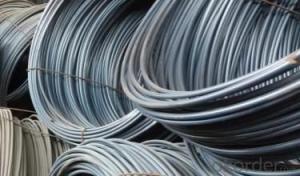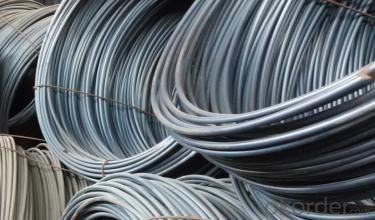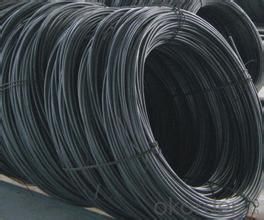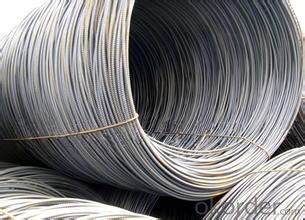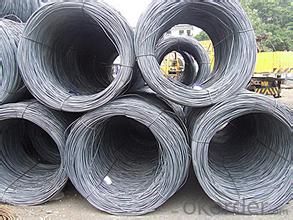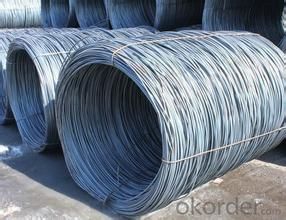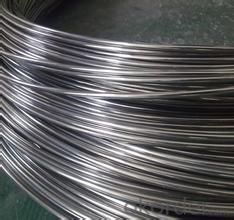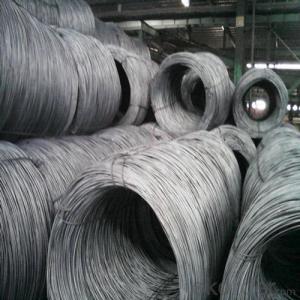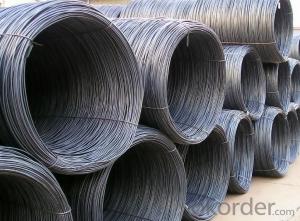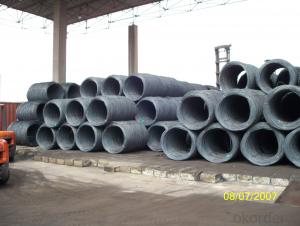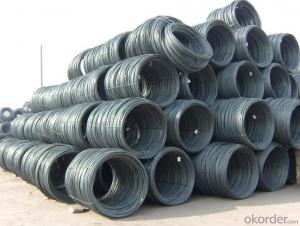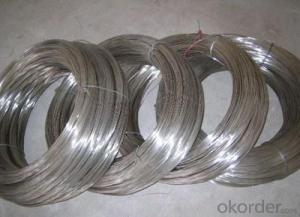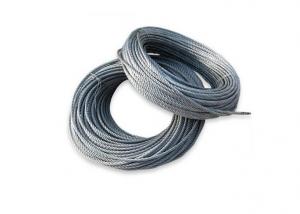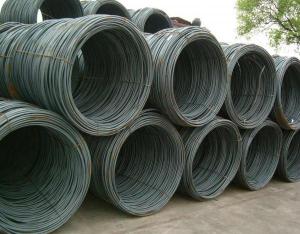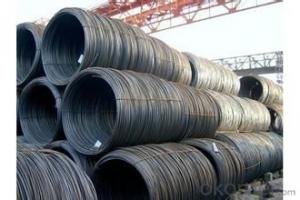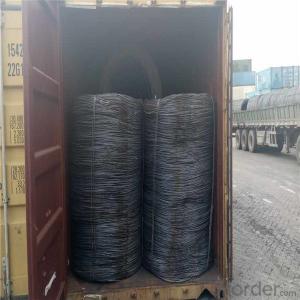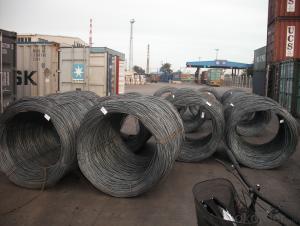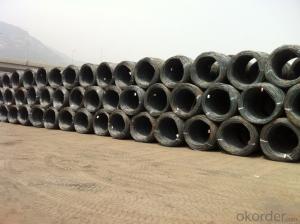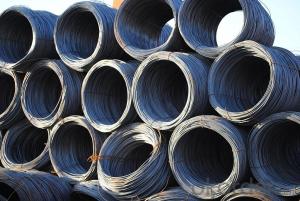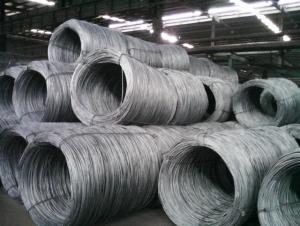high carbon steel wire rod/low carbon steel wire rod
- Loading Port:
- Tianjin
- Payment Terms:
- TT OR LC
- Min Order Qty:
- 50 m.t
- Supply Capability:
- 1000 m.t/month
OKorder Service Pledge
OKorder Financial Service
You Might Also Like
Specification
Description of wire Rod:
Product | wire rod |
| Standard | AISI, ASTM, BS, DIN, GB, JIS |
Material/steel grade | Q195/Q235,SAE1006-SAE1018B or according to customers requirements |
Wire Gauge | 5.5-18mm |
Coil weight | Around 2mt |
MOQ | 50MT |
Delivery Time | 35 days after receipt of L/C or deposit by T/T |
Packing | In coil and load in container, if large quantity, by bulk vessel; Can be packed as customers' special requirements |
Features of wire Rod:
1. Drawn wire specialist, your wire rod solution
2. ISO9001 Certified Mill &SGS
3. Feature: mach inability, high hardness, toughness, corrosion resistant
4. Clear and smooth surface, high precision and Tolerance control: ± 0.01
5. Customized service for your special requirement
6. Reasonable and more competitive mill price for you.
Applications of wire Rod:
1. Fasteners, bolts, rivets, screws
2. Electrode wires, industrial wires, agriculture wires
3. Bush wires, chain rivet wires, detonator wire, ACSR wires, earth wires
4. Stressed concrete wire, spring and rope wires
5. Automobile parts like screw, bush, socket, connecting rod, shaft, gear, engine shaft, connecting rod spindles, etc.
Images of wire Rod:
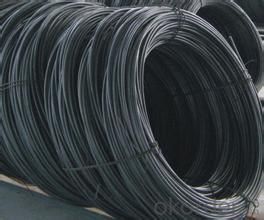
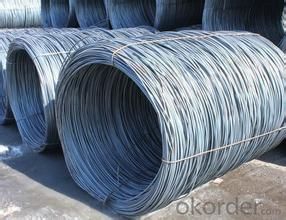
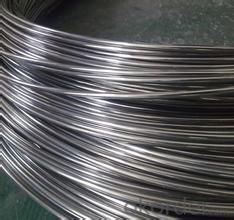
FAQ:
1. What's the Delivery port?
The main ports are Qingdao and Tianjin, we also can deliver to other ports to meet your requirements
2. How long is the lead time?
Delivery time: 45 days after order confirmed.
3. What payment term do you accept?
Payment: T/T or L/C at sight.
- Q: How does the tensile strength of steel wire rod vary with different diameters?
- The tensile strength of steel wire rod generally increases with larger diameters. This is because the larger diameter allows for more material, resulting in a higher capacity to withstand tension before breaking. However, it is important to note that other factors such as the specific alloy composition, manufacturing process, and heat treatment can also affect the tensile strength of steel wire rods.
- Q: What are the different types of steel wire rod surface cleaning processes?
- Various industries commonly utilize different types of processes to clean the surface of steel wire rods. These processes aim to eliminate contaminants like rust, scale, dirt, and oil, ensuring that the wire rod is clean and ready for further use or processing. The most frequently employed steel wire rod surface cleaning processes are as follows: 1. Pickling: In this process, the wire rod is submerged in an acid solution, typically hydrochloric acid, to eradicate surface impurities. The acid reacts with the contaminants, dissolving them and leaving the wire rod clean. 2. Shot blasting: Shot blasting involves propelling abrasive particles, such as steel shots or grits, onto the wire rod's surface at high velocity. This abrasive action removes rust, scale, and other impurities, resulting in a clean and textured finish. 3. Wire brushing: Wire brushing is a mechanical process that utilizes wire brushes to scrub the wire rod's surface. This process effectively removes loose rust, dirt, and other contaminants. 4. Chemical cleaning: Chemical cleaning entails the application of specific chemical agents to the wire rod's surface. These agents react with the contaminants, breaking them down and facilitating their removal. 5. Ultrasonic cleaning: Ultrasonic cleaning employs high-frequency sound waves to generate microscopic bubbles in a cleaning solution. These bubbles implode on the wire rod's surface, creating a scrubbing action that eliminates contaminants. 6. Electrochemical cleaning: Electrochemical cleaning, also known as electrocleaning, employs an electric current to eliminate surface impurities from the wire rod. The wire rod is immersed in an electrolyte solution, and the electric current causes the contaminants to dissolve. Each of these steel wire rod surface cleaning processes possesses its own advantages and limitations. The selection of a process depends on factors such as the type and severity of contamination, the desired level of cleanliness, and the specific requirements of the application.
- Q: How is steel wire rod used in the production of wire strands for electrical transmission lines?
- Steel wire rod is an essential component in the production of wire strands for electrical transmission lines. These wire strands are used to provide the necessary strength and conductivity for transmitting electricity over long distances. The process begins with the steel wire rod being drawn through various dies to reduce its diameter and increase its length. This drawing process helps to refine the steel and improve its mechanical properties, such as tensile strength and flexibility. Once the desired diameter is achieved, the steel wire rod is then twisted and formed into multiple individual wires, usually six or seven, which are then grouped together to form a wire strand. This twisting process helps to enhance the overall strength and durability of the wire strand. The wire strands are then coated with a protective layer, such as zinc or aluminum, through a process called galvanization. This coating not only provides corrosion resistance but also helps to improve the electrical conductivity of the wire strand. The wire strands are finally assembled into a larger conductor, along with other components such as steel or aluminum wires, to create the electrical transmission line. These transmission lines are responsible for carrying high voltage electricity from power plants to substations, where it is then distributed to homes, businesses, and other facilities. In summary, steel wire rod is a crucial raw material in the production of wire strands for electrical transmission lines. Through a series of processing steps, including drawing, twisting, and galvanization, the steel wire rod is transformed into wire strands that possess the necessary strength, conductivity, and durability required for transmitting electricity efficiently and reliably.
- Q: What are the major suppliers of steel wire rod?
- Some of the major suppliers of steel wire rod include ArcelorMittal, Nippon Steel Corporation, POSCO, Tata Steel, and Baosteel Group.
- Q: What are the disadvantages of using steel wire rods in construction?
- Using steel wire rods in construction has a few drawbacks: 1. Corrosion is a concern, particularly in humid and coastal areas. Steel is prone to rusting when exposed to moisture and oxygen, leading to structural weakness and deterioration. This compromises the project's integrity and increases maintenance costs. 2. Weight is another issue. Steel wire rods are heavy, making transportation and installation more difficult. The added weight can stress the foundation and supporting structures, potentially causing long-term structural problems. 3. Limited flexibility is a drawback compared to materials like concrete or timber. Steel wire rods are not as adaptable to complex architectural designs or unique construction requirements. 4. Cost is a consideration. Steel wire rods can be expensive, especially if high-quality materials are needed. The expenses of transportation, installation, and maintenance can also add up, making it less cost-effective for certain projects. 5. Thermal conductivity is high in steel, meaning it transfers heat quickly. This can result in increased energy consumption and higher heating or cooling costs for buildings made with steel wire rods. 6. Environmental impact is a significant concern. Steel production is resource-intensive and has a substantial environmental footprint. The extraction and manufacturing processes emit greenhouse gases and contribute to pollution. Additionally, disposing of steel wire rods at the end of their lifespan poses environmental challenges. In conclusion, while steel wire rods offer many advantages in construction, it is crucial to consider these disadvantages and explore alternative materials based on project requirements, environmental considerations, and budget limitations.
- Q: How is steel wire rod used in the manufacturing of suspension cables?
- Steel wire rod is commonly used in the manufacturing of suspension cables due to its high strength and durability. Suspension cables are essential components in various structures like bridges, suspension bridges, cable-stayed bridges, and suspension cable systems in buildings. These cables are responsible for carrying the load of the structure and ensuring its stability. Steel wire rod is the primary material used to make suspension cables because of its unique properties. The high tensile strength of steel wire rod allows it to withstand heavy loads and forces without breaking. This strength is crucial in suspension cables as they need to support the weight of the entire structure and resist the forces of wind, earthquakes, and other external factors. In the manufacturing process, steel wire rod is first drawn through a series of dies to reduce its diameter and increase its length. This process, called wire drawing, refines the steel wire rod and improves its mechanical properties. The resulting wire is then coated with a protective layer, such as zinc or epoxy, to prevent corrosion and increase its lifespan. After the wire has been processed, it is twisted together with other wires to form strands. These strands are further twisted together to create a cable. The number of strands and the arrangement of wires within the strands depend on the specific requirements of the suspension cable. Once the suspension cable is manufactured, it is installed and tensioned in the structure. The high strength of the steel wire rod ensures that the cable can withstand the applied tension and support the weight of the structure effectively. The durability of the steel wire rod also ensures that the suspension cable remains reliable and safe for an extended period. In summary, steel wire rod plays a vital role in the manufacturing of suspension cables due to its high strength, durability, and corrosion resistance. It is the primary material used to create these cables, ensuring their ability to support heavy loads and maintain the stability of various structures.
- Q: What are the common production processes for high carbon steel wire rod?
- The common production processes for high carbon steel wire rod include steelmaking, hot rolling, heat treatment, and surface treatment.
- Q: How is steel wire rod used in the manufacturing of tire cords?
- The manufacturing of tire cords relies on steel wire rod because of its strength, durability, and flexibility. Tire cords are the materials that provide strength and stability to the rubber of a tire. In order to create tire cords, the steel wire rod is first drawn through a series of dies to reduce its diameter and increase its tensile strength. This process, called wire drawing, guarantees that the wire rod meets the specific requirements for tire cord manufacturing. Once the wire rod has been drawn to the desired thickness, it undergoes a metal coating process. This process involves applying a layer of brass or zinc to the wire surface to improve its adhesion to rubber. The metal coating also protects the wire from corrosion and enhances its fatigue resistance, ensuring the tire cord's longevity and performance. The coated wire rod is then twisted into strands, usually in a helical pattern, to form tire cord yarns. These yarns are embedded within the rubber matrix during the tire manufacturing process, providing reinforcement and enhancing the tire's structural integrity. The steel wire rod used in the manufacturing of tire cords plays a critical role in improving the strength and durability of the tire. The high tensile strength of the steel wire rod allows the tire cords to withstand the significant forces and loads experienced by tires during operation, such as acceleration, braking, and cornering. Additionally, the flexibility of the wire rod enables the tire cords to conform to the tire's shape and absorb shocks, resulting in a smoother ride and improved overall performance. In conclusion, steel wire rod is an essential component in tire cord production. Its strength, durability, and flexibility make it an ideal material for reinforcing tires, ensuring safety and long-lasting performance on the road.
- Q: What are the different coatings available for steel wire rod?
- Some of the different coatings available for steel wire rod include zinc, galvanized, copper, epoxy, and polyethylene coatings. These coatings provide various benefits such as corrosion resistance, improved durability, and enhanced aesthetics for different applications.
- Q: What are the different types of steel wire rod surface cleaning methods for wire drawing?
- In the wire drawing process, various methods are commonly employed to clean the surface of steel wire rods. These methods play a vital role in eliminating impurities and ensuring a polished and superior final product. 1. Acid Pickling: Acid pickling is extensively utilized to clean steel wire rod surfaces. This technique involves immersing the wire rod in a solution of hydrochloric acid, which effectively eliminates rust, scale, and oxide layers. By removing surface impurities, acid pickling prepares the wire rod for subsequent wire drawing processes. 2. Electrolytic Cleaning: Another prevalent method for purifying steel wire rod surfaces is electrolytic cleaning. This process entails passing an electric current through the wire rod submerged in an electrolytic solution. The current effectively dissolves and separates contaminants from the wire rod surface. Electrolytic cleaning is especially effective in eliminating oils, greases, and other organic substances. 3. Mechanical Cleaning: Mechanical cleaning involves physically scrubbing and cleaning the wire rod surface using abrasive materials or brushes. This technique can be performed manually or with specialized machinery. Mechanical cleaning is highly efficient in removing stubborn dirt, rust, and scale from the wire rod. 4. Shot Blasting: Shot blasting is a process that involves propelling small metallic or non-metallic particles onto the wire rod surface at high velocities. The impact of these particles effectively eliminates surface contaminants, scale, and rust. Shot blasting is particularly useful for cleaning wire rods with intricate shapes or hard-to-reach areas. 5. Ultrasonic Cleaning: Ultrasonic cleaning employs high-frequency sound waves to generate tiny bubbles in a cleaning solution. These bubbles collapse upon contact with the wire rod surface, creating a scrubbing action that removes contaminants. Ultrasonic cleaning is highly effective in eliminating fine particles, oils, and greases. Each of these steel wire rod surface cleaning methods possesses its own advantages and limitations. The selection of the appropriate method depends on various factors, such as the type of contaminants, wire rod composition, and desired level of cleanliness. Choosing the right cleaning method is crucial to achieve optimal wire drawing performance and produce high-quality wire products.
Send your message to us
high carbon steel wire rod/low carbon steel wire rod
- Loading Port:
- Tianjin
- Payment Terms:
- TT OR LC
- Min Order Qty:
- 50 m.t
- Supply Capability:
- 1000 m.t/month
OKorder Service Pledge
OKorder Financial Service
Similar products
Hot products
Hot Searches
Related keywords
